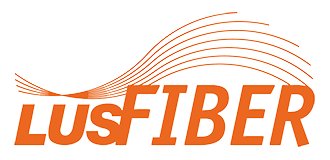LUS Fiber • Speed of Light
The Science of Fiber Optic Communication
Fiber optics have revolutionized the telecommunications industry in the Information Age. By using pulses of light transmitted through hair-thin strands of glass, fiber optic communication provides faster speeds and larger bandwidths than traditional electric cable.
Fiber optics (sometimes called optical fibers) are long, thin strands of very pure glass about the diameter of a human hair. They are arranged in bundles called optical cables and used to transmit light signals over long distances.
This exhibit sponsored by:
Fiber Optic Cable vs. Copper Wire
Hands on Display
A set of interactive displays demonstrates the differences between the speed and bandwidth of fiber optics and copper wire. Rotate the wheels on each display to compare how the size of photons and electrons affect speed and how differences in bandwidths affect the rate of data transfer. The final case demonstrates how fiber optics combines smaller particles with the larger bandwidth resulting in a faster telecommunication network.
Internet Through the Ages
VR Experience
In this virtual reality experience, students can explore the evolution of the Internet from dial-up to broadband to the fiber-connected home of today.
